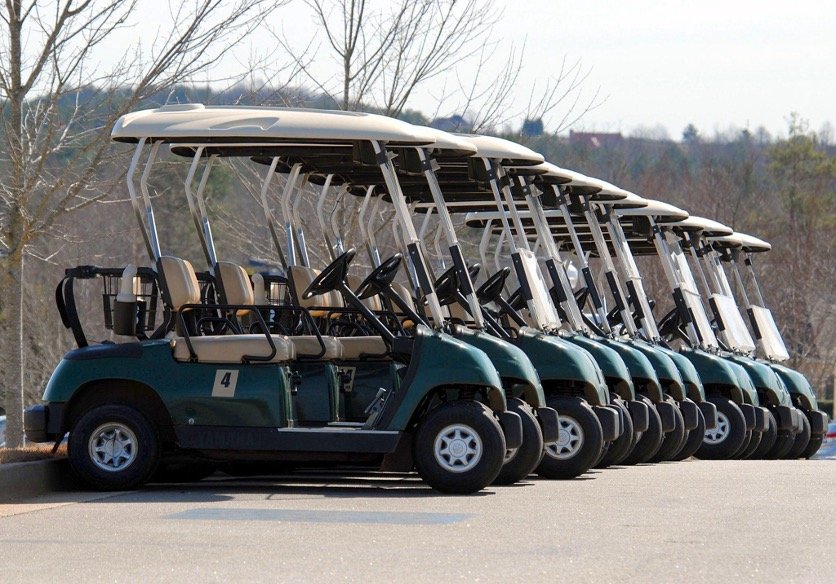How fast can golf carts go

Golf carts on a course | @Paulbrennan
With the advent of golf carts, the game of golf has experienced a subtle but fundamental alteration. These vehicles have become an essential aspect of the golfing experience, altering how golfers traverse the perfectly maintained courses. Various golf carts have been produced throughout the years, each with a distinct speed and specification. All of which will be explored in this article as their top speeds.
Purpose of Golf Carts

A golfer beside two carts | @mikhailnilov
Golf carts have become indispensable tools for golfers, offering a practical solution to movement across expansive golf landscapes. The main purpose of the golf cart is convenience and efficiency for golfers. Before now, the traditional method of conveyance for players was strolling the fairways with clubs in hand. Golf carts present a modern solution that allows individuals to traverse the course with ease.

A family spending time on the golf course | @mikhailnilov
Whether transporting players between holes or transporting golf equipment, these compact vehicles are designed to enhance the overall efficiency of the game.
Golf carts serve as more than mere conveyances; they embody a response to the need for efficient navigation across the sprawling fairways. The decision to integrate these four-wheeled companions into the golfing experience stems from a thoughtful consideration of the game’s evolving dynamics. As courses extend their reach across diverse landscapes, from undulating hills to expansive greens, golf carts emerge as practical tools, providing a means for players to effortlessly traverse the course.
Variability Among Different Golf Carts

Electric-powered golf carts | @pixabay
Each golf cart is unique with its different specifications. From the amble of some to the zippy pace of others, golf carts traverse the fairways at varying speeds, leaving players with a choice as diverse as the courses they navigate. The differences in speed among golf cart models are a result of differences in the design and performance of each vehicle. From the type of power source to the engineering of the motor, these factors contribute to the variations in the speed of the golf cart.
Power sources stand out as a primary determinant of speed diversity among golf carts. Electric carts, drawing energy from batteries, are known for their quiet efficiency but often have specific speed limitations. On the other hand, gas-powered carts, fueled by internal combustion engines, boast a reputation for higher speeds, providing a brisker pace on the course.

Gas-powered golf carts | @athena
The design and construction of the motor also play a pivotal role in dictating a golf cart’s speed capabilities. High-torque motors, optimized for quick acceleration, can propel carts to higher speeds, catering to those who prefer a more spirited journey across the fairways. Conversely, carts equipped with motors tuned for efficiency may offer a steadier, more measured pace.
Course layouts emerge are also influencers of speed variability.
Carts designed with off-road capabilities may exhibit different speed profiles than those tailored for well-manicured fairways. The undulating landscapes of golf courses, with their slopes and contours, further contribute to the nuanced speed experiences offered by different models.
Safety practices with Golf carts

Two golf carts keeping a safe distance | @Mikhailnilov
Some safety tips for handling the golf carts include:
- Adhere to Designated Speed Limits
- Maintain Awareness of Surroundings
- Mindful Maneuvering Around Tee Boxes and Greens – Exercise extra caution when navigating around these areas, as they demand a slower pace to prevent turf damage. Gentle turns and careful steering ensure a respectful passage through these critical zones.
- Use Cart Paths Where Available – Golf courses often provide designated cart paths to guide players through the course without traversing playing areas. Whenever possible, use these paths to minimize the impact on the turf and maintain a consistent pace of play.
- Be Cognizant of Weather Conditions – Weather conditions can significantly impact the safety of golf cart operation. Wet or slippery terrain may require reduced speeds and heightened caution. Exercise prudence during adverse weather to prevent accidents and minimize wear on the course.
- Secure Golf Bags and Equipment – Check that golf bags and equipment are properly stored in the cart before departing. This reduces the danger of accidents and ensures a pleasant trip by preventing goods from moving during travel.
- Safe Distance Between Carts – Keep a safe space between your golf cart and other vehicles. This not only eliminates collisions but also enables all players on the course to go at a more relaxing and comfortable pace.
- Follow Course Etiquette – Understand and follow the golf course’s unique regulations and standards. Course etiquette is intended to create a pleasant atmosphere for all players, and adherence guarantees that everyone has a great experience.
Environmental factors affecting Golf cart speed
- Terrain Variation: The varied geography of golf courses, including slopes, undulations, and hazards, has a significant impact on cart speed. Uphill climbs and difficult terrain may slow golf carts down, necessitating cautious navigation and lower speeds to avoid grass damage and erosion. Downhill portions, on the other hand, may need slower speeds to protect player safety and course preservation.
- Weather Conditions: The whims of weather, from rain to scorching sun, can significantly alter course conditions and affect cart speed. Wet and muddy terrain may necessitate slower speeds to prevent carts from skidding and causing damage, while extreme heat may require additional considerations to minimize stress on the turf.
- Course Maintenance Practices: Course maintenance, including aerating greens or applying fertilizers, can create temporary changes in course conditions. Golf carts must navigate these areas with heightened caution, and speed restrictions may be implemented to protect both the course and the effectiveness of maintenance efforts.
Adhering to designated speed limits, being mindful of course conditions, and incorporating eco-friendly practices all contribute to a holistic golfing experience. Beyond the greens, as utility carts find themselves woven into the fabric of diverse environments, the need for thoughtful speed regulations becomes even more pronounced.
Highlight
| Golf type | Speed | Uses |
|---|---|---|
| Electric-powered | 19-20 mph | Commonly used on golf courses for convenience. |
| Gas-powered | 19-20 mph | Also commonly used because it is suitable for all terrains |
| High performance | 25+ mph | These types of carts offer a higher speed for users |
| Off-road | 30+ mph | These carts are the most sophisticated and can be used on various terrains with a high speed. |